Ephemeroptera
Taxa on This Page
- Ephemeroptera
- Euplecoptera
- Permoplectoptera X
- Triplosobidae X
Ephemeroptera
Mayflies
The following page was written some years ago, from a mostly Linnaean perspective, and is in need of revision and updating, as well as conversion to the current Palaeos format. In the meantime it has been posted as is MAK120517
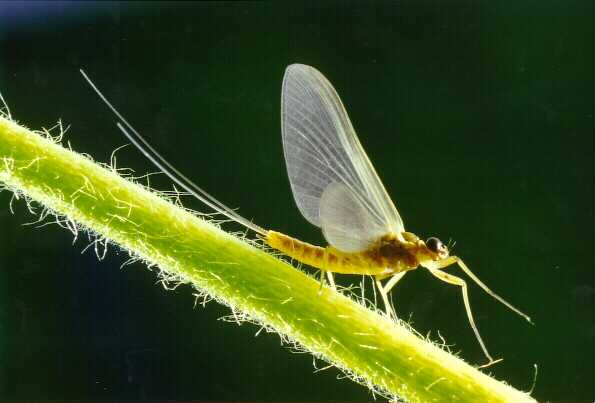
Rhithrogena sp - family Heptageniidae
image from Ephemeroptera Galactica
The Ephemeroptera are among the most primitive of flying insects. They are delicate, elongate Palaeopteran insects with net-veined wings, of which the second-pair is reduced in size and function and in advanced forms may be absent. The wings are held vertically over the body at rest. There are two or three causal ("tail") filiform appendages. The eyes are large and compound, the antennae short. The prothorax is small, the legs slender, the first pair elongate.
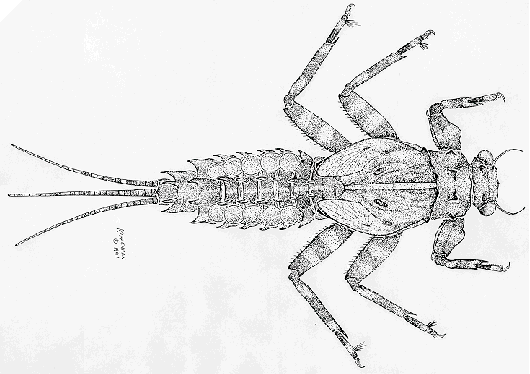
Drunella grandis nymph (family Ephemerellidae) length 1.4 centimeters
Illustration by B.C. Kondratieff, Colorado State University, from Ward, J.V. and B.C. Kondratieff.
The aquatic larvae or nymphs possess respiratory abdominal tracheal gills. Modern forms live in streams as they require running water (Paleozoic types probably preferred ponds swamps, and rivers). Most mayfly larvae are collector-gatherers or scrapers, being herbivores or scavengers (usually feeding on diatoms, bottom detritus, etc). Only a few forms being carnivorous. Most mayflies in temperate regions spend most of their one-year life cycle as nymphs, although some species may live for two or three years. In adult Euephemeroptera the mouthparts are vestigial, they do not feed, but live only briefly to breed. Depending on the weather and the species, adults live from one hour to several days.
There are three suborders Protephemeroptera, the Permoplectoptera, and the Euephemeroptera or Euplecoptera, which last group includes all surviving forms. The following dendrogram (modified from one on Mikko's Phylogeny pages with the addition of a number of extinct taxa) shows a very approximate and simplistic representation of these groups. In fact it is almost certain that the Permoplectoptera are paraphyletic, including among their number the direct ancestors of modern groups
Suborder Protephemeroptera
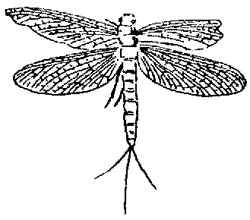
Triplosoba pulchella
family Triplosobidae
wingspan about 4 cm
Stephanian Epoch (Upper Productive Coal Measures) - Gzhelian epoch
Commentry (Allier), France
graphic from Karl Von Zittel's Text-Book of Paleontology
The Suborder Protephemeroptera contains the species Triplosoba pulchella, from the latest Carboniferous of Europe. This is so different to later mayflies that it has in the past been placed in a separate order (the tendency nowadays is to include it under the Ephemeroptera proper). Unlike modern mayflies, these creatures fed normally upon attaining adulthood. Also unlike modern mayflies, the larvae apparently did not require flowing water. The fore- and hind-wings are similar, with a very primitive pattern of wing venation, and numerous cross-veins, although with some intercalary veins extending longitudinally. The thorax and abdomen consist of similar segments, the legs likewise are similar. The cerci are long.
 Although similar in appearance to the true Ephemeroptera, its wing veneation (left) (unbranched MA and pectinately branched Rs) exdudes it from the direct line of mayfly descent. Nevertheless it does represent something of a transitional form (in a sense a grand-uncle rather than a grand-father) between the Palaeodictyoptera and the true Ephemeroptera
Although similar in appearance to the true Ephemeroptera, its wing veneation (left) (unbranched MA and pectinately branched Rs) exdudes it from the direct line of mayfly descent. Nevertheless it does represent something of a transitional form (in a sense a grand-uncle rather than a grand-father) between the Palaeodictyoptera and the true Ephemeroptera
Triplosoba pulchella - wing (after Edmunds and Traver 1954) from Riek, p.174
Suborder Permoplecoptera
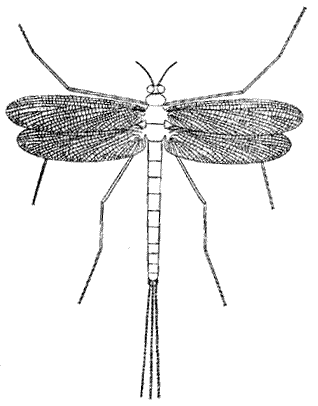
Protereisma permianum,
Early Permian
Note the fore and hind-wings are of more or less equal size.
graphic from Carpenter, 1933, reprinted in Reik
The Suborder Permoplecoptera includes a number of more typical forms known from the Permian of North America Russia, Australia, and a single Mesozoic lineage. They differ from some of the more slender Palaeodictyoptera of the time, which they otherwise resembled, chiefly in venational characters and in possessing a long caudal style. Unlike recent mayflies, which do not have functional mouths as adults, the Permoplectoptera had chewing mouthparts as adults. Another way they differed from modern species of mayflies is in the wings, the fore and hind wings being approximately the same size (technically, in which fore and hind wings were "subequal" in size). Apart from a few doubtful nymphs, there is no further record of the Ephemeroptera until the Jurassic, when two families of the surviving suborder Euephemeroptera (Euplectora) appeared. The Mesephemeridae, which retained the nearly homonomous wings of the Permoplectoptera, survived well into the Cretaceous as a sort of "living fossil" alongside its more derived Euplectopteran descendents.
Roy Beckemeyer has a number of illustrations of Permoplecoptera on his Fossil Insects site
Suborder Euplecoptera
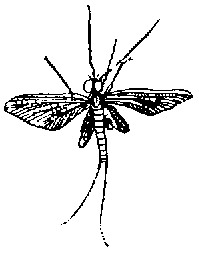
Cronicus anomalus (Pictet)
An extinct genus of the family Siphlonuridae
Early Oligocene - Baltic Amber
wingspan about 2 cm
graphic from Karl Von Zittel's Text-Book of Paleontology
(note - this drawing shows the eyes too large in proportion to the body - c.f. the figure in Carpenter, Treatise O24, fig.16-2)
 The suborder Euephemeroptera or Euplectoptera can be used to distinguish all recent mayflies and their immediate ancestors and relatives. These more typical forms have vestigial mouthparts, and the hind wings are smaller or even absent. A number of families appeared during the early Jurassic, representing some seven or eight distinct lineages. In fact during the Jurassic the diversity of the Ephemeroptera reached its highest extent, fossils of nine families have been found during this period. Although there are more living families known, the Jurassic diversity would have been much higher, as only a small proportion of types would ever be fossilized. It is possible that most of these forms evolved during the latest Triassic, a time of great evolutionary diversification. Among the Jurassic forms, the Paedephemeridae had considerably reduced hind wings. A several of these families represent Recent groups.
The suborder Euephemeroptera or Euplectoptera can be used to distinguish all recent mayflies and their immediate ancestors and relatives. These more typical forms have vestigial mouthparts, and the hind wings are smaller or even absent. A number of families appeared during the early Jurassic, representing some seven or eight distinct lineages. In fact during the Jurassic the diversity of the Ephemeroptera reached its highest extent, fossils of nine families have been found during this period. Although there are more living families known, the Jurassic diversity would have been much higher, as only a small proportion of types would ever be fossilized. It is possible that most of these forms evolved during the latest Triassic, a time of great evolutionary diversification. Among the Jurassic forms, the Paedephemeridae had considerably reduced hind wings. A several of these families represent Recent groups.
Links:
Note: following links have not been revised
UCMP -Ephemeroptera - Mayflies - the best coverage of the group
Fossil Insects - by Roy J. Beckemeyer
Günter Bechly, Ephemeroptera - technical diagnosis of the group, including extinct forms. Excludes the Protephemeroptera/Triplosobidae from the Ephemeroptera.
The Fossil Record II (ed. Mike Benton) - on-line database
Tree of Life project Ephemeroptera
Palaeoptera - Mikko's Phylogeny - dendrogram and a few references
 Although similar in appearance to the true Ephemeroptera, its wing veneation (left) (unbranched MA and pectinately branched Rs) exdudes it from the direct line of mayfly descent. Nevertheless it does represent something of a transitional form (in a sense a grand-uncle rather than a grand-father) between the Palaeodictyoptera and the true Ephemeroptera
Although similar in appearance to the true Ephemeroptera, its wing veneation (left) (unbranched MA and pectinately branched Rs) exdudes it from the direct line of mayfly descent. Nevertheless it does represent something of a transitional form (in a sense a grand-uncle rather than a grand-father) between the Palaeodictyoptera and the true Ephemeroptera




